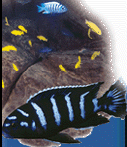

AFRIČKI CIKLIDI
Cyrtocara |
Cyrtocara Boulenger 1902Cyrtocara moorii (Boulenger 1902) The monotypic genus Cyrtocara, from the Greek noun kara meaning head, and adjective kyrtos meaning curved, curved head, was erected in 1902 by G. A. Boulenger and re-described in 1989 by Eccles & Trewawas for the single species moorii Boulenger 1902. Cyrtocara moorii had been re-classified in the genus Haplochromis by Ethelwynn Trewawas in 1935 (Trewawas 1935), as the diagnosis; "a continuous margin in the dorsal fin" by Regan was not considered enough for the erection of a new genus. C. moorii was taken back to Cyrtocara in 1989 when more characters were found by the same Trewawas that guaranteed the validity of the genus (the genus Haplochromis had being limited then to some cichlids outside Lake Malawi). Diagnosis for the genus as Eccles and Trewawas (1989), include an "adult size of up to 190 mm", a "caudal fin scaly and emarginated, body moderately deep". A "large suprapectoral, a supra anal and a precaudal spot, but these are often obscured by the an overall deep blue coloration". "Head profile characteristic, adults and sub-adults of both sexes with a dermal frontal gibbosity which increases disproportionately with fish size". The "stout conical form of the teeth is unique to Cyrtocara". And several more traits. Cyrtocara moorii shows unique chracteristics of a Malawian cichlid not presenting a striking sexual dimorphism. On the basis of a continuous margin in the dorsal fin (The main diagnostic trait of the genus), instead of being divided into lappets attached to the spines, Regan (1922) included two additional species to Cyrtocara; Nimbochromis venustus Boulenger 1908 and Protomelas annectens Regan 1922. Trewawas (1935) noted that in N. venustus the entire edge occurred only in mature males, while lappets were present in females or inmature males. Because of it's many peculiarities, Cyrtocara was considered by Trewawas (1989) to be a monotypic genus.
Cyrtocara moorii is found in sandy areas all throughout lake Malawi on shallow water rarely deeper than ten meters. It feeds by following the large sandsifters Taenilethrinops praeorbitalis and T. Laticeps in their deep digging search for invertrebrates, In the process C. moorii will defend it's host. C. moorii will take advantage of the debris stirred up, where it gets the small invertebrates upon which it feeds. Cyrtocara moorii may also feed independently on zooplankton or filamentous algae, although it lacks any specialization for these diets and such feeding is probably facultative at times of particular abundance of the items concerned. References
|